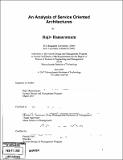An analysis of service oriented architectures
Author(s)
Ramaratnam, Rajiv
DownloadFull printable version (9.859Mb)
Alternative title
Analysis of SOA
Other Contributors
System Design and Management Program.
Advisor
Michael A. Cusumano.
Terms of use
Metadata
Show full item recordAbstract
Introduction: Corporations all across the globe and of various sizes rely on their IT systems for business processes, reduction of process lifecycle and management of resources. These systems house several applications for internal sales, purchasing, finance, HR and so on. In any such typical organization, IT systems are a heterogeneous mix of hardware, operating systems and applications. Many of these applications run on different operating systems like Windows systems, Linux and Unix systems, etc. Oftentimes there is a need to consolidate data or access data from several such systems. The diversity among systems and applications makes these tasks difficult, time consuming and tedious. Furthermore, there is also a need for synchronization of data across systems and applications to ensure that the data is accurate and up-to-date. The heterogeneous nature of systems and applications lead to high levels of redundancy of data, making data maintenance a huge overhead for organizations. Today's organizations must also adapt to changes in environments both external and internal to them. Such changes could be changing market conditions, reorganization, change in business strategies within a company, addition or changing suppliers, partnerships, mergers and acquisitions and so on. There is also a growing need for integration across enterprise boundaries to facilitate fast and seamless collaboration between partners, customers and suppliers. All such needs entail changes to existing IT systems within an organization in a timely manner. There is thus a growing need for integration of such systems for consolidated decision making, accurate, up-to-date system information, better performance and system monitoring. IT Systems must also be flexible to respond to changes in the environments of their organization. Enterprise Application Integration is a process that aims to bring about such integration. The need for integration goes beyond the boundaries of an enterprise. Further, to successfully compete today, businesses need to be flexible. This means that their IT systems need to be able to keep pace with dynamic business conditions. It is evident that any solution for multiple IT systems to integrate with each other and to provide flexibility, they must be able to communicate and coordinate activities in a standard way. For almost two decades, many companies have tried to use CORBA, DCOM and similar technologies but have had little success. None of these technologies, for many reasons have become global technologies. The arrival of standards like HTTP and HTML helped linking together millions of humans across the internet but proved inadequate to link together computer systems. Moreover, internal and cross enterprise integration and coordination bring with them, security implications as both involve information exchange between organizational entities. As we will see later, the traditional methods of securing applications with firewalls prove inadequate for application security. One insight that has come from failed attempts to consolidate and coordinate IT systems is that such efforts cannot be limited to IT alone. Decision making on how interdepartmental and inter-enterprise data must data must be exchanged must be made by leaders and opinion shapers at each level or division of the organization. It is the goals of internal and external enterprise integration, flexibility of business processes, and enterprise data security that has led more and more organizations to adopt to Service Oriented Architectures (SOA). The adoption, implementation and running of a SOA does not simply involve IT department heads to design and create a new architecture for the enterprise. It involves a holistic understanding of the nature of the entire enterprise, its business and internal processes, the corporate strategy for the enterprise, an understanding of the business processes of the enterprise, its partners, suppliers, subsidiaries, etc. Such an undertaking is beyond the scope of a single department or division of the enterprise. The creation and running SOA architecture thus involves the coordination of all parts of the enterprise.
Description
Thesis (S.M.)--Massachusetts Institute of Technology, System Design and Management Program, 2007. Leaf 96 blank. Includes bibliographical references (leaves 88-95).
Date issued
2007Department
System Design and Management Program.Publisher
Massachusetts Institute of Technology
Keywords
System Design and Management Program.